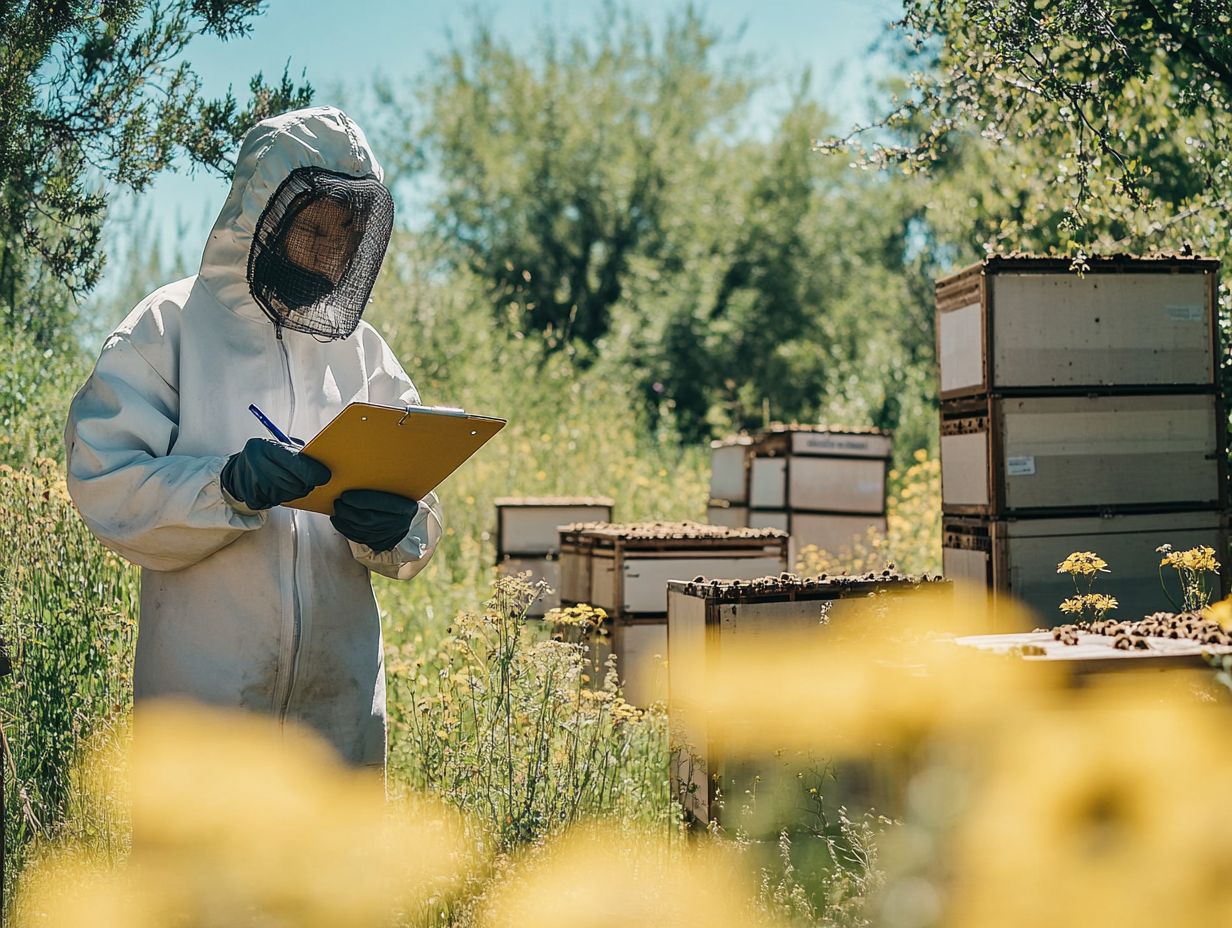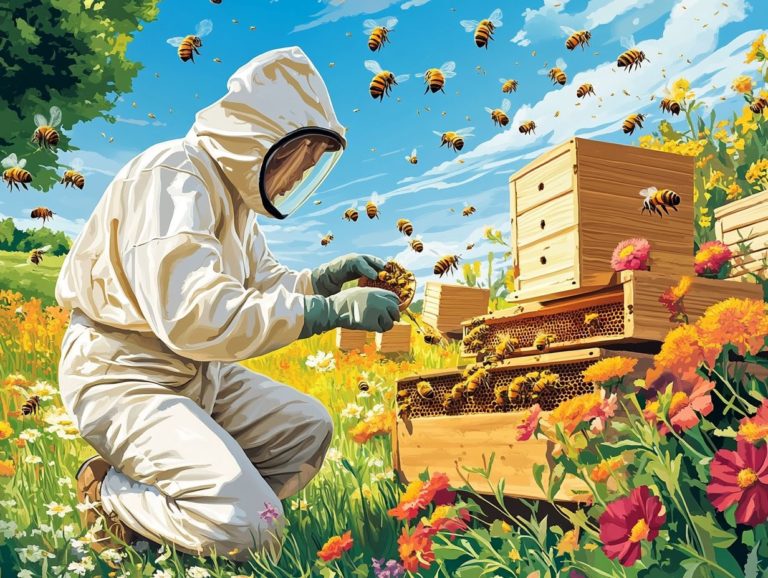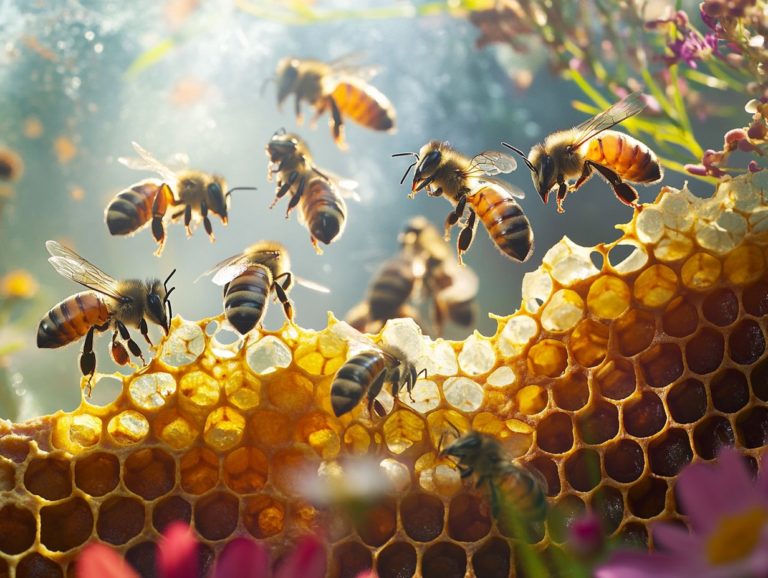How to Prioritize Hive Management Tasks
Get ready to unlock the secrets of effective hive management! This article will guide you through the key tasks that every beekeeper must prioritize for thriving colonies and abundant honey.
Effective hive management is essential for any beekeeper who seeks to maintain thriving colonies and maximize honey production, leveraging productivity techniques and task prioritization.
This article delves into the key aspects of hive management, highlighting the importance of prioritizing tasks to ensure the well-being of your bees. You ll learn to identify urgent responsibilities and understand seasonal needs, all while acquiring practical strategies for managing your hives efficiently using powerful project management tools and task management software.
Key tasks that every beekeeper should focus on will be underscored, along with tips for staying organized with Kanban boards and task lists in your hive management efforts. Embrace this opportunity to elevate your beekeeping skills to new heights!
Contents
Key Takeaways:

What is Hive Management?
Hive management is all about nurturing strong bee colonies while maximizing honey production. This involves understanding their seasonal life cycle and ensuring they remain healthy and free from pests.
This intricate process requires you to grasp the seasonal lifecycle of bees and oversee hive health. You must also manage pests like Varroa mites and adeptly apply best practices in beekeeping while managing stress effectively.
Organizations such as Hives.co offer cutting-edge tools and resources designed to give you the power to fine-tune your hive management strategies for optimal results, using customized scorecards and task prioritization matrices.
Why is Prioritizing Hive Management Tasks Important?
Prioritizing hive management tasks is essential for ensuring that your key activities align with organizational goals and contribute to the overall health and productivity of your honey bee colonies, using clear goals.
By effectively managing your time and resources, you can pinpoint the most impactful tasks. You can leverage feedback ratings and implement strategic prioritization techniques to improve hive outcomes.
This collaborative decision-making process enables you to address urgent needs while simultaneously fostering sustainable beekeeping practices and engaging multiple stakeholders in task organization.
How to Prioritize Hive Management Tasks?
When you prioritize hive management tasks, it s essential to adopt a systematic approach that assesses and ranks activities based on their urgency, impact, and alignment with your strategic objectives. By employing effective prioritization techniques, you can streamline your task management processes with productivity tools designed to enhance your workflow.
This method gives you the power to concentrate on high-impact tasks that directly influence honey production and the overall health of your hives.
1. Identify Urgent Tasks
Identifying urgent tasks is a crucial step in effective hive management, allowing you to focus on immediate concerns that could impact the health and productivity of your bees.
Techniques such as assessing hive conditions through task categorization and monitoring for signs of distress will help you pinpoint which tasks demand your prompt attention, ensuring that the most pressing issues are addressed efficiently.
This proactive approach is essential because procrastinating on urgent matters like pest infestations or signs of disease can have dire consequences for your colony. You can utilize checklists and task lists to systematically evaluate hive performance, looking for indicators such as reduced foraging activity or unusual bee behavior that signal a need for immediate action.
Embracing technology, such as hive monitoring systems, can further assist you in tracking environmental changes and hive metrics. By prioritizing urgent tasks, you not only safeguard your hive’s current health but also enhance its long-term viability, ultimately refining your overall management strategy.
Start implementing these hive management strategies today and see the difference in your colonies!
2. Consider the Time-Sensitivity of Tasks
Recognizing the time-sensitive nature of hive management tasks is essential for productivity. Meeting the needs of honey bees throughout their seasonal lifecycle is crucial.
Tasks like swarm management and winter preparations demand timely execution to yield favorable results and maintain hive stability. Utilizing time tracking can help ensure these tasks are completed on schedule.
As the seasons change, you must adapt your strategies to sidestep potential pitfalls. In the spring, performing timely inspections and implementing swarm prevention plans is crucial. Colonies tend to grow rapidly, and neglecting these needs can lead to swarming, ultimately diminishing honey production.
As fall approaches, prioritize essential preparations for winter. Make sure your bees are well-fed and ready for the colder months by ensuring adequate food stores and proper hive insulation. By understanding these critical timeframes, you can optimize hive health and productivity, creating a positive ripple effect on the entire ecosystem you support.
3. Evaluate the Impact of Tasks

Evaluating the impact of your hive management tasks is essential for understanding how each activity influences the overall health of the hive and honey production. By analyzing feedback ratings and measuring the outcomes of various tasks, you can focus on those that offer the greatest benefits.
This assessment can take many forms, such as tracking honey yields and brood development over time. Engaging in surveys and user interviews with fellow beekeepers, alongside quantitative data, can uncover trends and pinpoint areas for improvement.
Utilizing technology, like hive monitoring systems, provides you with real-time insights into hive conditions. By systematically evaluating the results of specific hive management interventions, you can identify which practices yield the most positive impact and adjust your management strategies accordingly.
4. Prioritize Tasks Based on Seasonal Needs
Prioritizing tasks based on seasonal needs is crucial for effective hive management. The demands of honey bees change throughout the year, and you must adapt your strategies to ensure that essential tasks are completed at the optimal time.
In spring, your focus should shift to fostering population growth within the colony. This entails closely monitoring brood frames and implementing swarm control measures, which might involve adding supers to accommodate the expanding population.
As summer arrives, the emphasis transitions to maximizing honey production. You ll want to prioritize harvesting honey at just the right moment to prevent leaving your bees with insufficient stores for winter. Using Kanban boards can help in task organization during this crucial period.
Come autumn, your attention should turn to preparing the hive for the colder months. This includes ensuring that adequate food reserves are in place and possibly feeding the bees if natural nectar sources are scarce.
Understanding these seasonal shifts not only helps you efficiently prioritize tasks but also plays a vital role in maintaining a thriving hive.
Start organizing your hive management tasks today to ensure your bees thrive!
5. Delegate Tasks to Others
Delegating tasks to others is a powerful strategy in hive management. It helps you optimize your organizational skills and boost productivity. By involving multiple stakeholders in the hive management process, you can share responsibilities effectively. This ensures that all critical tasks are addressed without overwhelming any individual team member, enhancing user satisfaction.
This collaborative approach fosters a sense of ownership within your team and cultivates a wealth of diverse insights that can enhance your decision-making. For example, while one person focuses on monitoring the health of the bees, another can manage hive inspections, and a third can take charge of extracting and bottling honey. Using task automation can significantly improve efficiency.
By breaking down these tasks, you can markedly improve hive efficiency, leading to increased honey production and healthier colonies. Engaging team members in specialized tasks allows them to develop their skills. This contributes to a knowledgeable and capable group that reinforces the sustainability of the entire hive, similar to task delegation in effective project management.
What are the Most Important Hive Management Tasks?
In hive management, the most crucial tasks directly impact the vitality of your honey bee colonies and the effectiveness of your honey production. Using cognitive functions and executive functions will help guide task prioritization.
Key activities such as monitoring hive health, managing honey output, controlling pests and diseases, harvesting honey, and preparing for winter survival are paramount. Using task management tools can help streamline these efforts.
By prioritizing these essential tasks, you can cultivate thriving hives and secure the success of your beekeeping endeavors.
1. Monitoring Hive Health
Monitoring hive health is a crucial aspect of effective hive management. It enables you to spot potential issues like bee diseases and Varroa mite infestations before they spiral out of control. Implementing reliable methods for regular health assessments will help keep your hive strong and productive throughout its seasonal lifecycle.
Regular inspections are essential, combined with a keen eye on your bees behavior and colony dynamics. Look for signs of disease, such as unusual bee behavior or decreased brood production, which could indicate health problems like Nosema or chalkbrood. Evaluating indicators of hive strength like population size and honey stores will provide valuable insights into the overall well-being of your colony.
Using techniques like sticky boards will help monitor mite counts. Conducting thorough brood examinations will further enhance your understanding of hive conditions. This proactive approach allows for timely interventions that bolster your hive s resilience against various threats.
2. Managing Honey Production
Managing honey production requires a deep understanding of the seasonal lifecycle of bees. Implementing best practices that optimize yield is essential. As a beekeeper, embrace task automation and meticulous planning to ensure honey is harvested at the ideal moment. This enhances both its quality and quantity.
Be aware of the various stages of bee activity throughout the year from the bustling early spring bloom, when bees are most active in foraging, to the late summer focus on honey storage. By utilizing advanced hive management techniques, such as temperature monitoring and pest control systems, you can maintain healthy colonies.
Incorporating task automation tools will streamline your routine inspections and data collection. This allows you to concentrate on strategic decision-making while minimizing labor. By harmonizing these elements, you can create a thriving environment that maximizes honey production and sustains your bees for the long haul.
Start implementing these techniques today to see a thriving hive tomorrow!
3. Controlling Pests and Diseases

Controlling pests and diseases is crucial for maintaining healthy colonies, as these threats can greatly impact hive productivity and longevity. Employ effective strategies to monitor for common issues like Varroa mites and other honey bee diseases. This ensures you implement appropriate interventions swiftly.
A multi-faceted approach is essential. Conduct regular inspections to spot early signs of infestation or illness. Utilize sticky boards and remove drone brood to keep an eye on Varroa mite populations. Routine hive assessments enable you to detect diseases like American foulbrood or Nosema.
Your treatment options will vary from chemical miticides to organic treatments. Each requires specific application guidelines that you must follow closely. Implement combination pest control methods like fostering genetic resistance through breeding and promoting environmental diversity to enhance your hive’s health and resilience against these pervasive threats.
4. Harvesting and Processing Honey
Are you ready to maximize your honey yield? Get excited about harvesting and processing honey it s the key to successful hive management! Know when to extract honey. Use effective methods to process it for better production.
Typically, plan your honey harvest for late summer, right when the nectar flow has peaked and the bees have capped the honey cells a sure sign the honey is perfectly ripened. Timing is of the essence here. If you harvest too early, you risk ending up with honey that has high moisture content, which can lead to fermentation.
Once you extract the honey, navigate through various processing stages. Start with filtering to eliminate wax and impurities before bottling it for storage and sale. Regularly inspect your hives and ensure optimal conditions for your colonies. This contributes to both the quantity and quality of your final honey product.
5. Preparing for Winter
Preparing for winter is essential for the survival of your colony during the colder months. Don’t wait! Implement strategies designed to strengthen your hive and provide adequate resources to sustain the colony through the seasonal lifecycle. Embrace winter survival strategies like managing Varroa mite populations and ensuring food stores.
Start by assessing the overall health of your hive, including the population size and the availability of food stores. It’s vital to ensure your bees have enough honey reserves, as this energy source is critical for survival when foraging becomes impractical due to cold and inclement weather.
Consider insulating your hives to shield the colony from temperature extremes, all while ensuring proper ventilation to prevent moisture buildup. By taking these thoughtful steps, you can significantly enhance the resilience of your honey bees and support their survival through the challenges of winter.
How to Stay Organized and Efficient in Hive Management?
Maintaining organization and efficiency in hive management is crucial for maximizing your productivity and ensuring that every task is completed on time. By leveraging productivity tools and implementing effective methods for task organization, you can streamline your operations and significantly enhance both the health of your hives and your honey production.
Now is the time to apply these concepts and take action!
1. Create a Hive Management Schedule
Create a hive management schedule. This schedule is essential for your organization throughout the beekeeping season. It sharpens your organizational skills and allows for seamless task management.
Set a clear timeline for inspections, feeding, and harvesting. This will help you stay proactive about hive health, rather than scrambling to react to issues. Integrating notes on seasonal changes, pest control measures, and colony growth into this schedule further enhances its effectiveness.
Prioritizing ideas using customized scorecards and feedback ratings helps in making strategic decisions. You might consider utilizing digital tools or physical planners to keep track of critical actions, ensuring you remain on top of your responsibilities.
Aligning yourself with local beekeeping events or resources can provide valuable support in maintaining this vital schedule. Resources from experts like Noriaki Kano and Stephen R Covey can offer additional insights into task prioritization and effective methods.
Your thriving hives and rewarding beekeeping experience are just a few steps away!
2. Use Technology and Apps
Using technology and apps for hive management can boost productivity. They help you track tasks, manage hive health, and automate processes with ease. Tools like Asana and Evernote make your use of time and resources more efficient.
By integrating modern monitoring tools, you gain access to real-time data on hive conditions like temperature and humidity, which are critical for maintaining bee health. Task automation features take the hassle out of routine activities such as feeding schedules and pest management.
Analyzing historical data through these applications empowers you to make informed decisions, enhancing the overall sustainability of your hives. Ultimately, embracing these technologies leads to healthier bees and a more productive apiary, effectively supporting the growing demands of local ecosystems and honey markets.
3. Keep Detailed Records

Maintaining detailed records is crucial for tracking your colonies’ health. This practice helps you make informed decisions based on historical data, while also ensuring that tasks are organized efficiently.
Regularly document hive inspections, pest management treatments, and seasonal honey production. This promotes accountability and allows you to spot trends that can enhance colony performance.
Noting environmental factors like weather patterns and flowering times provides valuable insights into your bees’ behavior and productivity. Techniques such as task prioritization matrix and Kanban boards a visual way to organize tasks can help in organizing and managing these records effectively.
Whether you prefer using digital apps or traditional notebooks, effective record-keeping methods enhance communication among beekeepers. This sharing of insights fosters community learning and drives advancements in your hive management techniques.
4. Continuously Educate Yourself on Best Practices
Continuously educating yourself on best practices for managing bee hives is essential for boosting productivity and ensuring the long-term health of your honey bee colonies. Staying informed about advancements in beekeeping techniques helps you adapt your methods for better hive outcomes.
This ongoing education can take many forms. Consider attending local workshops for hands-on experience and networking with fellow beekeepers. Online courses provide a flexible alternative, allowing you to learn at your own pace while accessing a wealth of information from seasoned professionals.
Books, research articles, and reputable websites are excellent resources for keeping up with the latest findings and strategies in beekeeping. Using these tools sharpens your skills and improves your decision-making when facing challenges in your hives, ultimately ensuring strong colonies and maximizing honey yields.
Frequently Asked Questions
What are some essential hive management tasks to prioritize?
Essential hive management tasks include:
- Monitoring hive health
- Checking for pests and diseases
- Maintaining proper ventilation and temperature
- Regularly inspecting and cleaning the hive
How do I manage hive tasks if I’m short on time?
When time is limited, focus on critical tasks for hive survival, such as checking for pests and ensuring enough food and water are available.
Is there a specific order for prioritizing hive management tasks?
While there is no one-size-fits-all order, prioritize tasks related to hive health and survival before honey production activities.
How can I manage multiple hives effectively?
Establish a schedule for hive management tasks to ensure all hives are regularly inspected and maintained. Prioritize tasks based on each hive’s needs and communicate any concerns with the responsible beekeeper.
What should I do if I’m unsure about prioritizing hive tasks?
Consult with an experienced beekeeper or attend a workshop for valuable insights on effective hive management practices.
Take Action! Join a local beekeeping group or sign up for a workshop to enhance your skills and knowledge.





